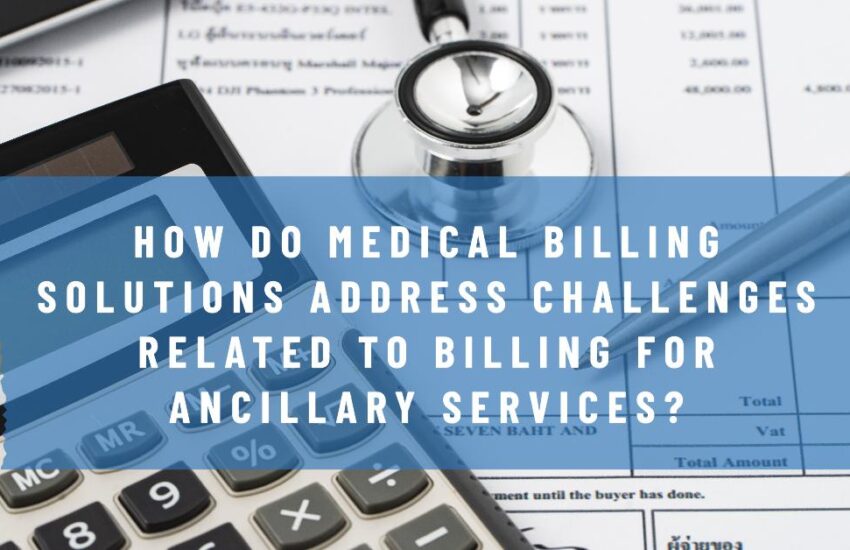Navigating the world of medical billing can be complex, especially when it comes to ancillary services. These are the additional medical services that enhance patient care, from lab tests to physical therapy sessions, yet they come with their own set of billing complications. Medical billing solutions are essential in managing these challenges, helping healthcare providers accurately bill for Medical Billing and Coding while maintaining compliance and transparency.
Understanding Ancillary Services in Healthcare
What Are Ancillary Services?
Ancillary services support the primary care a patient receives and are often categorized as diagnostic, therapeutic, or custodial. These services include lab tests, imaging, rehabilitation therapy, and even home healthcare.
Examples of Common Ancillary Services
- Diagnostic: Blood tests, X-rays, MRIs
- Therapeutic: Physical therapy, occupational therapy
- Custodial: Home healthcare, hospice care
Ancillary services play a critical role in diagnosing and treating patients effectively, but billing for them can get tricky.
Challenges in Billing for Ancillary Services
Complex Coding Requirements
Billing for ancillary services often involves detailed coding that varies by service. Codes need to be accurate for claims to go through, but the complexity of these codes is challenging to manage without robust systems.
Managing Multiple Service Providers
Since ancillary services are provided by various professionals, managing and consolidating bills from multiple providers can lead to confusion if not properly tracked and coordinated.
Frequent Changes in Regulations
Insurance policies and healthcare regulations change regularly, making it difficult for healthcare providers to keep up. Failing to stay updated on these changes can result in claim denials.
Patient Confusion Over Additional Charges
Ancillary services can often come with unexpected charges that patients may not fully understand, leading to questions and potential dissatisfaction.
Importance of Medical Billing Solutions
Medical billing software is a powerful tool that streamlines the billing process, ensuring that all aspects of healthcare billing, including ancillary services, are managed efficiently. These solutions help reduce administrative burdens, improve accuracy, and enhance compliance with insurance policies.
How Medical Billing Solutions Tackle Coding Complexities
Coding for ancillary services can be highly specialized. Medical billing solutions come equipped with comprehensive coding databases that help ensure the right codes are used for each service. Automated coding features reduce the likelihood of human error and facilitate faster, more accurate billing.
Ensuring Compliance with Insurance Regulations
Compliance is critical in the healthcare industry. Medical billing solutions offer regular updates aligned with new regulations, ensuring that every bill complies with the latest insurance and legal standards. This keeps billing practices up-to-date and reduces claim rejection rates.
Automation in Billing Processes
By automating billing for ancillary services, healthcare providers can save time and reduce manual errors. Automation eliminates repetitive tasks, such as data entry, which allows staff to focus on more complex billing issues and patient care.
Integration with Electronic Health Records (EHR)
Integrating medical billing solutions with Electronic Health Records (EHR) helps streamline patient data management. With EHR integration, billing information is automatically updated, reducing the risk of errors and enhancing accuracy in billing for ancillary services.
Patient Transparency and Communication
Medical billing solutions improve transparency by providing detailed breakdowns of charges, which helps patients understand what they’re being billed for. Clear communication can enhance patient satisfaction and reduce disputes over charges RCM.
Handling Multiple Providers and Services
For facilities that coordinate services across multiple providers, medical billing solutions consolidate billing data into one streamlined process. This unified billing approach helps healthcare organizations present a clear, itemized bill to patients and insurance companies alike.
Claims Management and Denial Handling
With ancillary services, claim denials are common, especially if there are coding errors or compliance issues. Medical billing solutions include claims management features that identify potential denial reasons and support quick resolutions. These solutions also aid in the appeals process, helping recover denied payments.
Reporting and Analytics in Ancillary Billing
Advanced reporting features in medical billing software provide valuable insights into billing trends, denial rates, and revenue generation. These insights enable healthcare providers to make informed decisions and optimize their billing processes over time.
Customizable Billing Options
Different healthcare providers have unique billing needs, especially when it comes to ancillary services. Customizable billing solutions allow practices to adapt billing processes to fit their specific service offerings, making it easier to handle various types of ancillary services.
Improving Revenue Cycle Management (RCM)
Medical billing solutions are critical for effective Revenue Cycle Management (RCM). By automating the billing process, ensuring accurate coding, and reducing claim denials, these solutions help healthcare providers optimize their revenue cycle, ensuring faster payments and fewer financial discrepancies.
Conclusion
Medical billing solutions are essential for healthcare providers that want to streamline and optimize billing for ancillary services. From handling complex coding to integrating with EHR systems and managing multiple providers, these solutions address many of the common challenges. As a result, they enhance efficiency, maintain compliance, and improve transparency, all of which contribute to better patient satisfaction and a healthier revenue cycle.
FAQs
1. Why is billing for ancillary services so complex?
Billing for ancillary services involves specialized coding and frequent regulatory updates, which can be difficult to manage without an advanced billing solution.
2. How do billing solutions prevent errors in ancillary service billing?
Billing solutions automate data entry, provide coding support, and offer compliance updates, which help reduce errors and improve accuracy.
3. Can billing software help smaller practices with ancillary billing?
Yes, billing software is beneficial for both large and small practices, as it simplifies the billing process, minimizes errors, and ensures timely payments.
4. What role does automation play in billing for ancillary services?
Automation reduces manual work, lowers error rates, and speeds up the billing process, allowing healthcare staff to focus on patient care rather than paperwork.
5. How can patients better understand their ancillary service bills?
Billing solutions improve transparency by providing clear, itemized bills and simplifying communication about charges, which helps patients understand their bills better.
